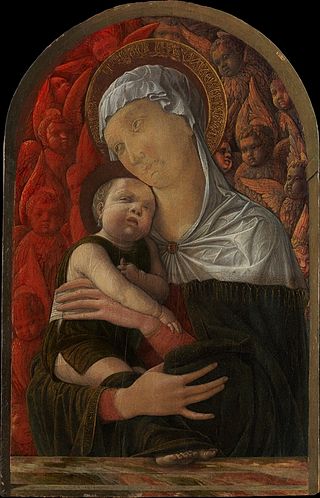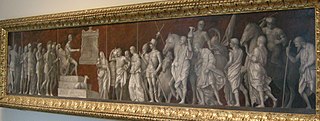
Anthony "Fat Tony" D'Amico is the name of two recurring characters in the animated sitcom The Simpsons. Both are voiced by Joe Mantegna and first appeared in the episode "Bart the Murderer" of the third season. Fat Tony is a mobster and the underboss of the Springfield Mafia. His henchmen include Legs, Louie, and Johnny Tightlips, and he answers to Don Vittorio DiMaggio. Upon the death of the original Fat Tony in the episode "Donnie Fatso" of the twenty-second season, the character's near-identical cousin of the same name is introduced. The characters somewhat resemble real-life mobster Anthony "Fat Tony" Salerno.

Andrea Mantegna was an Italian painter, a student of Roman archeology, and son-in-law of Jacopo Bellini.

Joseph Anthony Mantegna is an American actor.

St. Sebastian is the subject of three paintings by the Italian Early Renaissance master Andrea Mantegna. The Paduan artist lived in a period of frequent plagues; Sebastian was considered protector against the plague as having been shot through by arrows, and it was thought that plague spread abroad through the air.

The Lamentation of Christ is a painting of about 1480 by the Italian Renaissance artist Andrea Mantegna. While the dating of the piece is debated, it was completed between 1475 and 1501, probably in the early 1480s. It portrays the body of Christ supine on a marble slab. He is watched over by the Virgin Mary, Saint John and St. Mary Magdalene weeping for his death.
Gia Cristine Mantegna is an American actress. She is known for her role as Devin Levin on the ABC sitcom The Middle.

The San Zeno Altarpiece is a polytych altarpiece by the Italian Renaissance painter Andrea Mantegna created around 1456–1459. It remains in situ in the Basilica di San Zeno, the main church of the Northern Italian city of Verona. Mantegna's style mixes Greco-Roman classical themes along with Christian subjects in this altarpiece. The central panel, along with the three paintings that comprise the predella, were taken in 1797 by the French. While the main, central scene was returned by the French to Verona in 1815, the three predella paintings in Verona today are copies, since the original ones remain in France at the Louvre (Crucifixion) and in the Musée des Beaux-Arts in Tours. The paintings are made with tempera on panel; not oil as mistakenly identified in one source.

The Presentation at the Temple is a painting of the Presentation of Jesus at the Temple by the Italian master Giovanni Bellini, dating to c. 1460. It is housed in the Fondazione Querini Stampalia, in Venice, Italy.

The Adoration of the Shepherds is a painting by the northern Italian Renaissance artist Andrea Mantegna, dated to c. 1450-1451.

The Battle Between Love and Chastity is a painting by the Italian Renaissance artist Pietro Perugino, now in the Musée du Louvre, in Paris, France. It was originally commissioned for the studiolo (cabinet) of Isabella d'Este, Marchesa of Mantua, in the Castello di San Giorgio.

Joe Mantegna portrayed Robert B. Parker's detective "Spenser" in three TV films on the A&E cable network between 1999 and 2001.

The Allegory of Isabella d'Este's Coronation is a painting by the Italian Renaissance painter Lorenzo Costa the Elder, dating to about 1505–1506. It is displayed in the Louvre Museum of Paris, France.

The Parnassus is a painting by the Italian Renaissance painter Andrea Mantegna, executed in 1497. It is housed in the Musée du Louvre of Paris.

The Crucifixion is a panel in the central part of the predella of a large altarpiece painted by Andrea Mantegna between 1457 and 1459 for the high altar of San Zeno, Verona (Italy). It was commissioned by Gregorio Correr, the abbot of that monastery.

"The Revolutionist" is an Ernest Hemingway short story published in his first American volume of stories In Our Time. Originally written as a vignette for his earlier Paris edition of the collection, titled in our time, he rewrote and expanded the piece for the 1925 American edition published by Boni & Liveright. It is only one of two vignettes rewritten as short stories for the American edition.

The Reign of Comus is a Renaissance painting painted by Lorenzo Costa for the Studiolo of Isabella d'Este in the Ducal Palace, Mantua. It is in tempera on canvas, and measures 152 cm by 238 cm. It is now in the Louvre in Paris.

The Mantegna funerary chapel is one of the chapels of the Basilica of Sant'Andrea, Mantua. It houses the tomb of the painter Mantegna and his last two paintings – Baptism of Christ and Holy Family with St John the Baptist, St Elizabeth and St Zacharias (1504–1506). Its frescoes from 1507 were painted by his sons Ludovico and Francesco and by a young Correggio. The tomb bears a bronze figure of Mantegna by Gianmarco Cavalli.

The Butler Madonna or Madonna and Child with Cherubim and Seraphim is a tempera on panel painting measuring 44.1 by 28.6 cm. It is attributed to Andrea Mantegna, dated to around 1460. Its poor conservation, including over-harsh restoration to Mary's face, means that some art historians cannot accept it as an autograph work and theorise that it was produced by a follower of Mantegna after an autograph original. Its provenance is unknown before 1891, when it appeared for sale at a London art dealer. It was purchased by Charles Butler, from whom it passed to the Metropolitan Museum of Art in New York in 1926, where it still hangs.

The Continence of Scipio or An Episode from the Life of Publius Cornelius Scipio is a painting in oils on canvas by Giovanni Bellini, dating to 1507–08 and now in the National Gallery of Art in Washington, D.C.
Judgement of Solomon is a tempera on canvas painting of the Judgement of Solomon attributed to Andrea Mantegna and his collaborators. Dating to around c.1495, the painting is now in the Louvre,


















